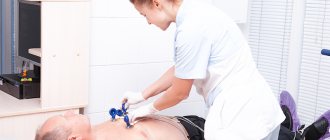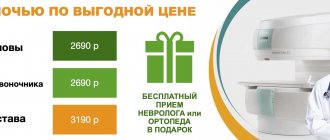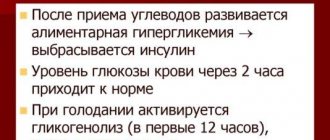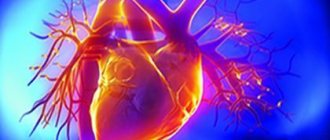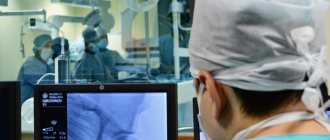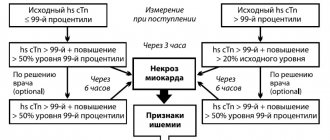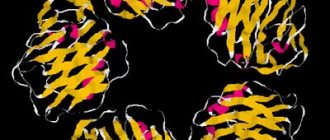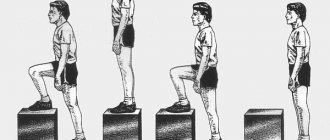How is the treadmill test performed?
The name of this stress test deciphers the nature of the study: a treadmill is a treadmill on which the test is carried out. An ECG is most often recorded during the study. Electrodes are attached to the patient's body, which continuously transmit information about the work of the heart muscle to record an ECG.
Treadmill test (stress test) - 4,900 rubles.
30-40 minutes
(duration of testing)
does not require hospitalization
During testing, the patient is asked to walk on a treadmill with a regular increase in load (increasing speed and inclination of the treadmill). All this time, an electrocardiogram is taken from the person being tested and his blood pressure is measured, the doctor and nurse monitor the patient’s general condition and breathing. During the testing process, the patient must also tell the doctor about his feelings - this complements the picture of the study.
The load increases until the doctor monitoring the instrument readings decides to stop testing. It is also possible to stop at the request of the patient himself, who feels unable to continue moving further due to shortness of breath, severe fatigue or chest pain.
After the test person has stopped moving, recording of the electrocardiogram and analysis of blood pressure continues for another ten minutes in order to analyze the characteristics of the body’s recovery after physical activity.
Why choose NEARMEDIC?
Qualified personnel
Bicycle ergometry (treadmill test) is performed by qualified cardiologists with many years of experience in conducting electrocardiographic examinations. Experienced specialists, candidates of medical sciences, doctors of the highest category will interpret the treadmill test and, if necessary, give valuable recommendations for the prevention and treatment of the disease.
Reliable high-precision equipment
To conduct the treadmill test in Moscow, expert equipment from the world's leading manufacturers of medical equipment is used. The rhythm and pulsation of the heart are recorded by precise and modern devices through several independent channels, blood pressure is measured by automatic devices, which eliminates the unreliability of the results.
Reviews of doctors providing the service - Treadmill Test
Thanks to the coordinated work of all the doctors and medical staff of the Center, I was provided with timely emergency care, and I am alive!
On October 28, 2020, he was brought by ambulance with an extensive myocardial infarction and stenting was performed. I thank Nadezhda Sergeevna Pakhomya! Her high level of professionalism combined with personal... Read full review Yulia Vladimirovna M.
26.04.2021
On October 30, 2020, I was hospitalized at the emergency clinic, I want to express my deep gratitude to all the employees who worked that day (unfortunately I can’t write all the full names), very qualified medical personnel, and I also express my gratitude to all the medical personnel who ... Read full review
Valentina Vasilievna S
05.11.2020
Contraindications
The treadmill test is of great diagnostic value for identifying a number of heart diseases , clarifying the diagnosis when the results of conventional electrocardiography are low, and assessing the effectiveness of prescribed therapy. At the same time, there are a number of pathologies for which the treadmill test is prohibited. Among them are recent acute myocardial infarction, severe heart failure, and severe vascular changes. Due to serious risks, treadmill testing is necessarily preceded by a comprehensive examination using safe techniques.
Why is a treadmill test required?
Unlike a conventional ECG taken at rest, a treadmill test provides information about the functioning of the cardiovascular system during physical activity (light, moderate, intense). This allows the cardiologist to choose the optimal treatment tactics and give recommendations to the patient regarding the recommended lifestyle and the body’s readiness for physical activity.
In addition, the treadmill test reveals so-called “silent” or “hidden” episodes of insufficient blood supply to the heart muscle and can signal the risk of hypertension, early manifestations of atherosclerosis, coronary heart disease and other cardiovascular diseases.
This test is also used to assess the work ability of persons with cardiovascular diseases.
Indications for the procedure
Doctors at the AlterMedica Medical Center recommend performing a treadmill test if the following indications exist:
- pain in the chest and behind the sternum;
- determination of exercise tolerance;
- identification of the patient’s belonging to a risk group for developing hypertension;
- assessment of the patient’s professional suitability (when working in extreme conditions);
- diagnosis of heart rhythm disorders;
- determination of latent cardiac circulatory failure against the background of hypercholesterolemia;
- determination of exercise tolerance in patients with coronary heart disease (to assess the functional class of angina pectoris);
- assessment of the effectiveness of therapy and rehabilitation in patients with coronary heart disease and myocardial infarction;
- determination of the working capacity of patients with cardiovascular diseases.
Contraindications
You should refuse to perform the study in the following cases:
- acute myocardial infarction (first 2-5 days);
- heart defects;
- acute myocarditis or pericarditis;
- acute dissecting aortic aneurysm;
- severe heart failure;
- uncontrolled heart rhythm disturbances;
- hypertensive crisis;
- history of thromboembolic complications;
- unstable angina.
An experienced doctor should determine contraindications to the treadmill test. Therefore, it is necessary to consult a cardiologist before the procedure. If limitations to the study are identified, the specialist will offer alternative diagnostic methods.
Preparing for the study
Before the treadmill test, it is necessary to stop some medications.
Among the medications whose intake is temporarily suspended are long-acting nitrates and beta-blockers. Drugs in these groups reduce heart rate and dilate coronary arteries. This may distort the results of the study. Cancellation must be agreed upon with the attending physician. The day before the test, it is recommended to stop smoking, drinking alcohol and coffee. On the day of the procedure, a light breakfast and a small amount of water are allowed.
You must also come to the treadmill test with ECG results.
How does the procedure work?
Immediately before the study, blood pressure is measured.
To record an ECG, electrodes are fixed to the chest, and a tonometer cuff is placed on the upper arm. During the examination, electrocardiography is recorded in three standard leads. After preparation, the treadmill begins to move. The initial speed is 2.7 km/h. Every 3 minutes the speed and incline increase. ECG data is also recorded every 3 minutes. If the heart has not adapted to the load, symptoms of ischemia appear. The average duration of the procedure is 20-30 minutes. Indications for stopping the study are patient complaints, registration of myocardial ischemia on the ECG, or achievement of submaximal heart rate.
Decoding the results
The test result is considered positive if the following signs are present:
- the appearance of chest pain (angina attack);
- development of a stable form of ventricular tachycardia;
- ST segment depression that lasts more than a minute;
- ST segment elevation by more than 1 mm.
If the patient has completed the calculated load, the test is negative. However, this result does not always guarantee the absence of damage to the coronary vessels. Therefore, the doctor may recommend performing a coronary angiography to clarify the diagnosis.
Treadmill test at the El.En clinic – professional and accessible
Preparing for the test includes avoiding certain medications, including sedatives, beta blockers, diuretics, etc., that can interfere with test results. Patients are recommended to stop smoking, drinking coffee, and eating 3 hours before the diagnosis.
Before the examination, it is important that the person is protected from stressful situations and high physical activity. At the first stage, a consultation is held, during which the doctor identifies possible contraindications to testing, talks in detail about the technique, and answers any questions of interest.
How is the examination carried out?
Testing takes place on a treadmill. While walking with increasing load, an electrocardiogram is recorded. The load increases over a certain time interval - the speed of the belt and the angle of inclination change. Essentially, the test creates conditions in which problems that trouble the patient in everyday life manifest themselves. Electrodes are first attached to the body. During the treadmill test, special equipment continuously measures the patient's blood pressure.
The results obtained are processed, after which the doctor announces their results to the patient. Data are assessed according to various indicators; the norm is considered to be readings that do not indicate abnormalities in the functioning of the heart - ischemic changes, blockages (patency), etc.
Doctors of the clinic "El.En." conduct professional data analysis and produce results. The duration of the treadmill test is 20-30 minutes, the exact time depends on a number of factors, including the individual characteristics of the patient. The study is completely supervised by a qualified physician.
Where to take a treadmill test in Moscow
If you are interested in the opportunity to conduct testing in comfortable conditions, without queues and with the participation of a professional medical team, come to El.En. The multidisciplinary clinic has modern equipment to conduct the test with highly informative and accurate results. You get all services in one place, saving time and money.
Sign up for diagnostics at a convenient time. At the first consultation, the doctor will talk in detail about testing, the cost of services and answer other questions.
Preparing for the treadmill test
Before performing the treadmill test you will need:
- get advice from a therapist (general practitioner) or cardiologist;
- do an ECG.
The last meal should be no later than 4 hours before the test. The day before the treadmill test, it is necessary to stop taking medications such as beta blockers and nitrates.
To take the test, you will need cotton socks and comfortable clothing that will not restrict your movements.
Preparation
When conducting a stress test, the attending physician cancels:
- vasodilators a few days before the test;
- antianginal agents, ACE inhibitors and calcium channel blockers 2 days before the test;
- nitroglycerin – 2 hours before the test;
- cardiac glycosides 14 days before the test;
In addition to stopping certain medications, in preparation for the test you should:
- 4-6 hours before the test, refuse to eat;
- reduce the amount of coffee you drink;
- exclude any physical activity;
Clothes should be comfortable, made of cotton.
Features of diagnostics
The treadmill stress test allows you to evaluate the work of the heart under load, with accelerated blood flow and increased contraction frequency.
To test, electrodes are attached to the body, through which the doctor monitors cardiac activity. Blood pressure is also continuously measured during the test.
The first stage of diagnosis involves walking. After 2-3 minutes the load increases - the speed increases or the angle of elevation changes. The load is dosed depending on the patient’s condition and indications. Heart function indicators are recorded on an electrocardiogram. Based on the goals of the study, the doctor can conduct a stress test on a treadmill, bicycle ergometry, and testing with a gas analyzer.
The examination is stopped in the following cases:
- achieving the parameters required for the study;
- achieving the required contraction frequency (the doctor determines it individually);
- the appearance of complaints of deterioration in health, which may be evidence of ischemia.
Indications
If the patient does not suffer from heart disease, he will be examined if:
- the need to determine the degree of endurance;
- the need to identify the presence of a hypertensive response to exercise;
- the need to identify heart rhythm disturbances;
- the need to identify hidden cardiac insufficiency in case of high cholesterol.
Indications for examination for persons with heart disease are:
diagnosis of various heart diseases, including ischemic heart disease, caused by insufficient blood supply to the myocardium; determination of the nature of heart rhythm disturbances; selection of a course of treatment and rehabilitation measures for persons who have suffered a myocardial infarction or patients with coronary artery disease; determining the ability to work of patients diagnosed with cardiovascular diseases.

